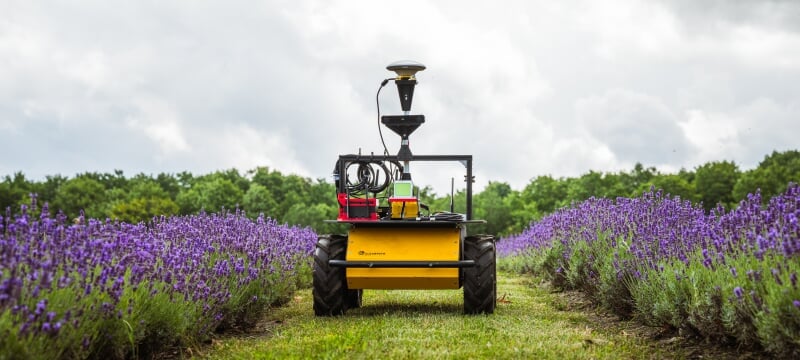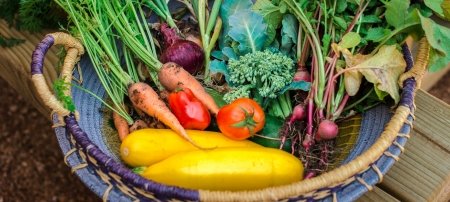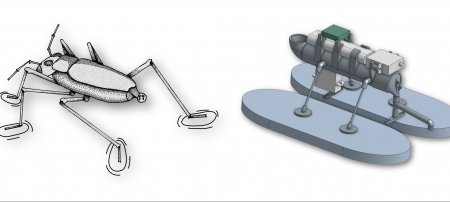Developing a fleet of agile and affordable lavender-harvesting robots is no easy feat. But with a goal to help small farms breathe easier, Jung Yun Bae and her fellow researchers keep calm and engineer on.
As the lavender fields of The Lucky Clover Farm in Gaylord, Michigan, bloomed last July, Michigan Tech researchers walked the fragrant rows, gauging robot mobility while collecting data that will be used to develop and train a lavender detection system.
Harvesting lavender requires a delicate touch as well as a discerning eye. The time-consuming process is made more complicated by labor force shortages and rising costs. Project leader Jung Yun Bae and her team are working with farmers to reimagine what it means to harvest by hand, deploying groups of small robots working in harmony that can be easily controlled, repaired, modified, and replaced. "We want to balance economy and function," she says.
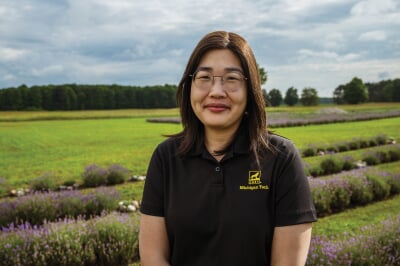
Funded through a $423,300 farm innovation grant from the Michigan Department of Agriculture and Rural Development, the two-year project focuses on using low-cost, modular robotic fleets to improve both climate resiliency and the economic return of labor-intensive produce. Bae's co-principal investigators are Vinh Nguyen and Myoungkuk Park. All three are faculty members in the Department of Mechanical and Aerospace Engineering.
During their visit this summer, researchers captured hundreds of images at various angles to document the seven species of organically grown culinary lavender cultivated at the farm. The flowers themselves are the product; sensors must recognize each variety and the robots must adapt to the particular harvest needs—such as shearing height—for each plant.
The robot that visited Lucky Clover was an armless prototype. Back at Tech, in the Intelligent Robotics and System Optimization Lab, team members are focused on developing the fabricated robotic arm that will be integrated with the software and mechanical capabilities to classify, pinpoint, grasp, secure, shear, and load the lavender.
Progress is also advancing as expected for the devilishly tricky task of synchronizing communications, allowing multiple robots to operate within a single, interchangeable platform.
Bae's seemingly serene acceptance of the difficulty of the process—the dead ends, the debugging, the starting over—is as soothing as the lavender flowers' delicate scent.
"Things kind of fall apart when we work to operate multiple communication systems. Integrating is not simple. There are a lot of sensors. A lot of algorithms. There are many layers required to extract features with the sensor data and make the necessary actions happen simultaneously. It takes patience and time," says Bae.
The end result is worth it: adaptable, easily operated robots tailored to the individual needs of farms and their specific crops. "If one is broken or they need to add one, the system can be flexible. If repairs are possible, fine, but rapidly advancing options and heterogeneity introduced into the system would let the farmers breathe a little bit—breathe easier," she says.
Growing Agricultural Tech in Michigan
Basing the innovative project in Michigan was natural from both a state and University perspective. While Michigan is the nation's third-largest lavender producer, it's far from the only crop making an impact on the state economy. Agriculture is Michigan's second-largest industry, and the Great Lakes State ranks second overall in the United States for agricultural diversity. No. 1 in national output for both asparagus and its legendary tart cherries, Michigan is a farming powerhouse that values specialty farms along with large agricultural operations.
"We want to be a part of making Michigan a hub for innovative, sustainable farming techniques."
Goliath farming operations have already invested in developing sophisticated robotic responses that address all the phases of crop tending, from seed to market. Bae notes that the equipment is generally cost-prohibitive and not to scale for smaller operations, whose role is crucial to sustaining a variety of produce that supplies local foodways and creates thriving economies.
Along with our historic commitment to serve the state's industries and contribute to its economy, Michigan Tech has the expertise in mechanical design, artificial intelligence, modern control algorithms, and autonomous navigation—along with the aforementioned patience—to carry out the project.
Romanticized Robots vs. Reality
Robots capture the human imagination, but like Transformers, there is more than meets the eye to building one. It's amusing to picture a Star Wars-esque R2-D2 coordinating a crew of C-3POs as they rapidly yet meticulously pluck delicate, five-lobed lavender corollas. But the Hollywood version of robotics isn't grounded in reality—yet. While there is an R2Weed2 farming robot on the market, designed to pull weeds while collecting data that assists with soil analysis and other environmental monitoring, Bae says most automated equipment currently available is neither priced nor scaled to suit the needs of small family-run farms.
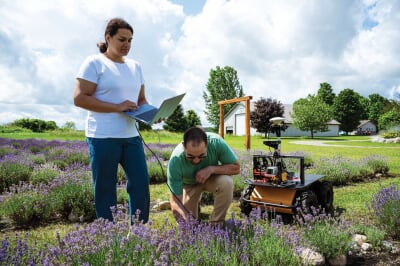
Her team plans to develop a fleet that's more practical—somewhere between sophisticated Autobots and a flock of situationally limited lavender Roombas. Researchers are specifically focused on equipment that is economically accessible, with customizable and expandable options for both small to midsized farms. But that doesn't make the project any less complex.
"Robots represent a lifetime of integration in a simple system. The things we learn as babies, robots must learn for the first time," says Bae. "It takes multiple demos to make sure each is working fine or to find the cause of why they are not. Every time we debug, we need to go back and make sure each component is working together. It's teamwork."
Lavender Fields Forever
While advances in agricultural automation for smaller farms have been minimal so far, they are growing. However, these operations are under economic pressure from multiple angles, making it increasingly difficult to remain viable, let alone find the extra money to expand infrastructure. An aging population, urban migration, farm consolidation, and changes in climate are some of the most serious challenges small farms face.
A path to resilience is being pioneered by researchers, state and local officials, and farm owners themselves, who recognize the compelling need to diversify and strengthen Michigan's agricultural economy while retaining the state's values and character.
The Lucky Clover Farm owner Jeanne Mouch lent her wholehearted support to Bae's project after her life partner Josh discovered the grant opportunity. He saw it as a way to combine his appreciation for both robotics and farming. "Josh is really a tech guy," says Bae. "Once we understood the need, we could come up with a solution."
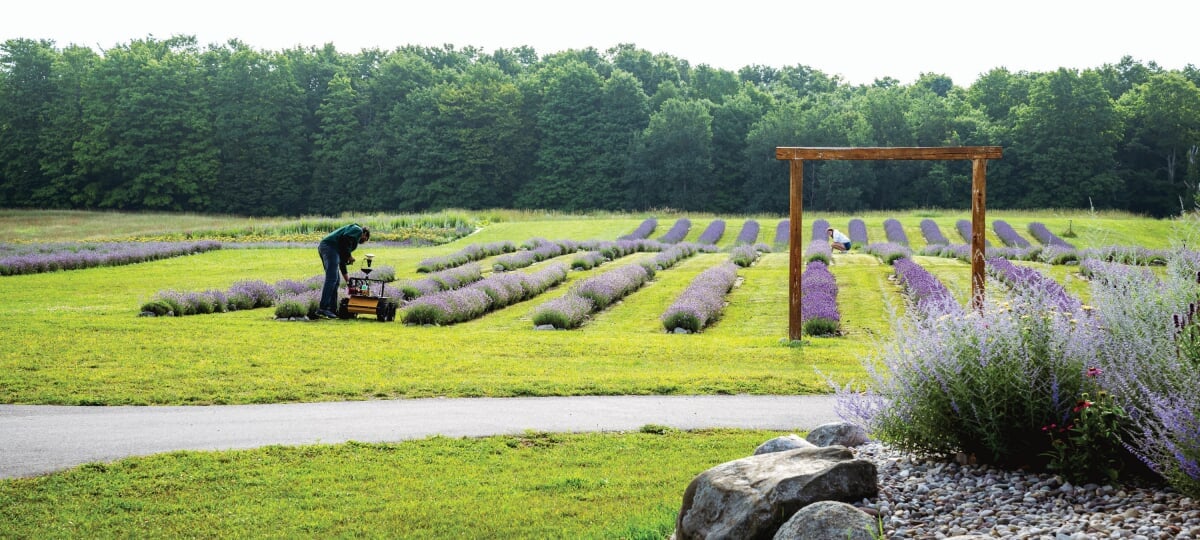
The Michigan Tech-led project is notable for its development of cutting-edge algorithms (pun intended) that will be used by multiple robots with advanced manipulators to bring in a complex harvest efficiently.
The technology will be applicable to other specialized crops. Bae and her team plan to work with the Michigan Manufacturing Growth Alliance to reduce the barrier to adoption by farmers through the Michigan Economic Development Corporation's Industry 4.0 Grant program. In addition, software and hardware platforms developed as an outcome of the project will be shared with the public through open-source platforms, further lowering the barriers to automation integration.
Bae and her team plan to conclude the lavender harvesting project with field demonstrations to help farmers and the public understand the project's potential to transform the future of small-scale agricultural automation in Michigan's farming landscape. Future goals include being able to network robots from a variety of manufacturers—an endeavor akin to coaxing a PC to play nice with a Mac.
"We want to be part of making Michigan a hub for innovative, sustainable farming techniques," Bae says. "While lavender is the target plant in this project, customization of outcomes enables the application to harvest other types of plants or crops. Our project can help to preserve or increase the number of small farms in Michigan, which leads to numerous benefits, including diversification of agricultural products, sustainable local agriculture, economic contribution, preservation of agricultural heritage, food security, and preservation of the rural landscapes and environment of Michigan."
Michigan Technological University is an R1 public research university founded in 1885 in Houghton, and is home to nearly 7,500 students from more than 60 countries around the world. Consistently ranked among the best universities in the country for return on investment, Michigan's flagship technological university offers more than 120 undergraduate and graduate degree programs in science and technology, engineering, computing, forestry, business, health professions, humanities, mathematics, social sciences, and the arts. The rural campus is situated just miles from Lake Superior in Michigan's Upper Peninsula, offering year-round opportunities for outdoor adventure.
